|
IMBERLEY TOAD BUSTERS NEWSLETTER
49:
16/02/2012
The Cane Toad is a Key Threatening Process to the Australian Nation
Declared by the Federal Government 12 April 2005
KTB Newsletter
This 49th
Kimberley Toad Busters’ Newsletter is produced by Kimberley Specialists
In Research Inc in conjunction with Kimberley Toad Busters Inc. Kimberley
Specialists, a founding member of the Kimberley Toad Busters,
continues to support
the campaign against the cane toad by supporting
www.canetoads.com.au
raising
funds and supporting cane toad scientific research.
Prepared by Jordy Groffen and Leonie Jacobs – KTB Scientists; in association with Gary Rethus, KTB
Biodiversity Coordinator. Edited by Lee Scott-Virtue KTB President & founder.
KTBs are a tax deductible entity. Please see our website for our
direct donation facility or how to sponsor toad busting or one of
our research or educational projects.
IF EVERYONE WAS A TOADBUSTER
THE TOADS WOULD BE BUSTED!
kimberleytoadsbusters@canetoads.com.au
www.kimberleyspecialists.com.au
kimberleyspecialists@westnet.com.au
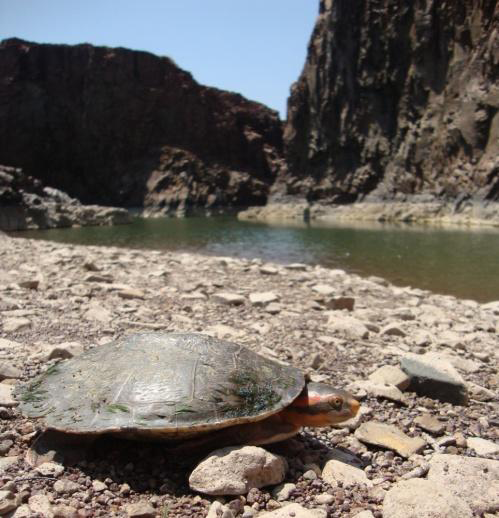
Red-faced turtle at Marella Gorge, WA |
The survey conducted in Marella Gorge on Nicholson
Station, the KTB southern depot and research station,
undertaken in October and November, showed species
richness and population size for freshwater crocodiles and
turtles.
Two species of freshwater turtles were found; the
sandstone snake-necked turtle (Chelodina burrungandjii)
and the red-faced turtle (Emydura victoriae). In addition the
survey recorded an estimate of the freshwater crocodile
(Crocodylus johnsoni) population.
KTB Biodiversity Coordinator Gary Rethus, with KTB animal scientists Jordy Groffen and
Leonie Jacobs recorded a total of 58 turtles. Only two species were recorded. These
included six sandstone snake-necked turtles and 52 red-faced turtles.
A total of 177
freshwater crocodiles were also recorded. The large number of turtles for such a small gorge system was a surprise. |
| “It is unusual to
find such a large turtle population number in a small waterhole, particularly as an adjacent
water hole, larger in size, inhabited very few
turtles” commented Gary Rethus. |
KTB
volunteers have noted that the Ringers Soak
Community does visit the large waterhole
regularly for swimming and fishing. It was
hypothesised that the larger waterhole may have
felt the impact of regular Indigenous fishing
which might have accounted for the reduced
number of turtles. KTB will resume monitoring
this area after the 2012/13 wet season to see if
there is any change in population numbers of
turtles. Marella Gorge is rarely visited during the
wet season so will have had some respite.
Marella Gorge is quite a confined system of approx. 2 km long
located 150km east from Halls Creek, Western Australia. It
contains a rich biodiversity and, as shown, many freshwater
crocodiles.
The Nicholson River flows in the gorge and ends in the
Ord River. It has deep permanent waterholes, steep escarpments,
and has an arid rocky spinifex country as habitat. “What is special
about this gorge system is that it is very hard for aquatic animals
to leave the gorge once they migrate into the system during the
wet season. |
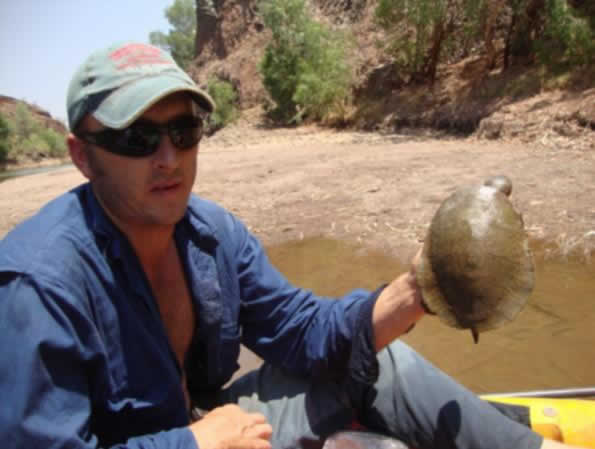
Gary Rethus, biodiversity officer at
KTB, with a red-faced turtle |
| Then being confined to the system until the following
wet season will almost certainly mean that cane toad impact is
much greater than in other, more open water systems”. |
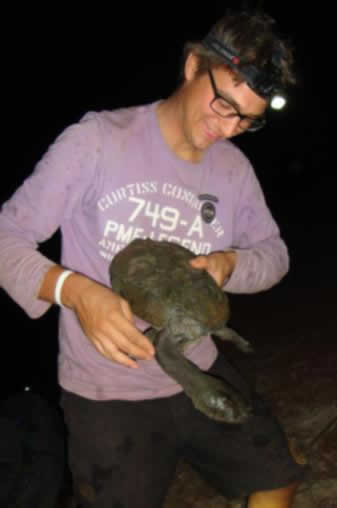
Jordy Groffen, researcher at
KTB with a sandstone
snake-necked turtle
|
Cane toads are known to have a negative effect on the freshwater crocodile populations. The
freshwater crocodiles, like other large predators, lack resistance to cane toad toxins, and
could die after ingesting cane toads. KTB scientist Jordy Groffen commented. “I expect a
great drop in freshwater crocodile populations in this area when
cane toads arrive. It could result in losses up to 100%, which is
devastating news”.
Crocodile populations in Victoria River Gorge
and the Victoria River-Wickham River Junction in the Northern
Territory dropped 70% and almost 80% respectively after cane
toad arrival. These systems are considerably larger than the
Marella Gorge system, and with a larger food system, ‘buy’ a little
more time before food resources become majorly impacted.
This
food resource impact will be felt very quickly at Marella Gorge and
freshwater crocodiles will begin feeding on the toads with
devastating effects. |
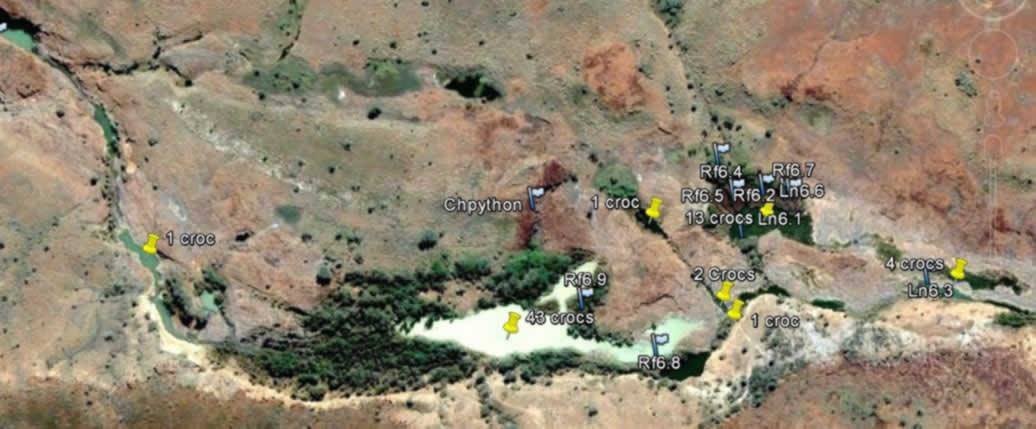
A Google Earth view from the survey area above the waterfall with the GPS markings
where the turtles were captured (trapped and caught by hand) and where crocodiles
were spotted.
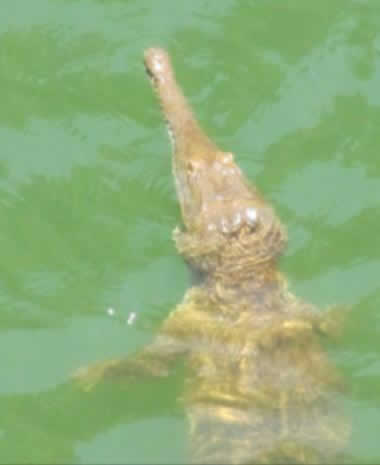
A large freshwater crocodile at Marella Gorge |
It is shown under experimental conditions that at
least 8 fish species and the sandstone snake-
necked turtle could die from ingesting cane toad tadpoles or eggs. However, some indirect
benefits were found for pig-nosed turtles
(Carettochelys insculpta) after the cane toad
arrived. Due to the cane-toad-induced declines
in lizard densities there was an increased
survival rate of turtle eggs, which were
previously at risk from varanid predation. KTB
scientist, Leonie Jacobs stated that “Cane toads will most likely have a negative effect
on turtle populations”. She added “We expect
decreased survival of the red-faced
turtle and sandstone snake-necked turtle, due to
possible deaths caused by the ingestion
of cane toad tadpoles, which is shown in
experimental studies”. |
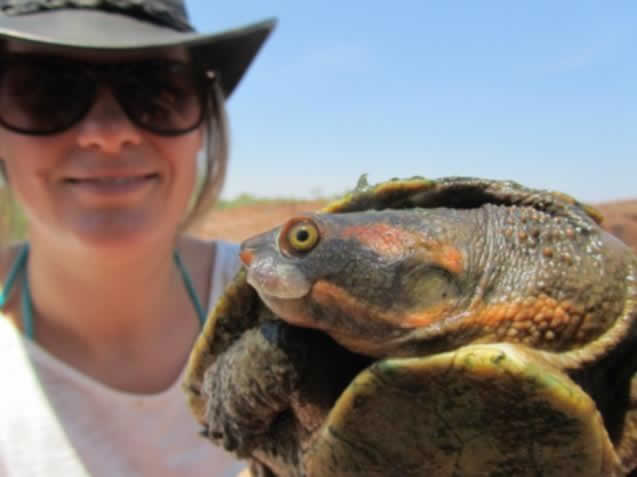
Leonie Jacobs, researcher at KTB
with a red-faced turtle
|
|
During this KTB study, turtles were caught by hand or trapped in opera house traps, which
were placed in shallow water so that turtles could still breathe. Fish was used to attract
turtles to the traps. Caught turtles were measured and notched for identification.
The survey will be repeated after cane toads have settled in the gorge system to investigate
cane toad influence on crocodile and turtle populations. “Ideally, this should be repeated
yearly to get a better insight in cane toad impact” Lee Scott-Virtue, President and founder of
KTB stated. “However funding for this research is hard to come by, particularly when it is
being undertaken by a volunteer group. However if we waited for the government and
universities to complete this work we will never understand the full impact of toads. Over 80
years after arrival, this information is still poorly understood”.
Red-faced turtle
Comments
This is the second part of a turtle and crocodile count facilitated by KTB and KSR. The initial
survey was conducted from
24-10-12 until 1-11-12. Turtle species identified were said to be
the North-Western red faced turtle and the Northern Long-necked turtle. Identification was
done using the latest published material however after communication with Dr. Nancy
FitzSimmons we were informed that the common names for the two species are now the red-
faced turtle and sandstone snake-necked turtle. Dr Fitzsimmons informed us that this
information is yet to be published and is a result of several years of study undertaken by her
and her team in the Kimberley.
For more information and/or data from this survey please go to our website
www.canetoads.com.au
Or contact us on kimberleytoadbusters@canetoads.com.au
Or 08 91682576.

Kimberley Toad Busters awards!
For more information on any of the articles contact:
Lee Scott-Virtue: KTB Founder & President 08 9168 7080 kimberleytoadbusters@canetoads.com.au
All donations are tax deductible.
|





